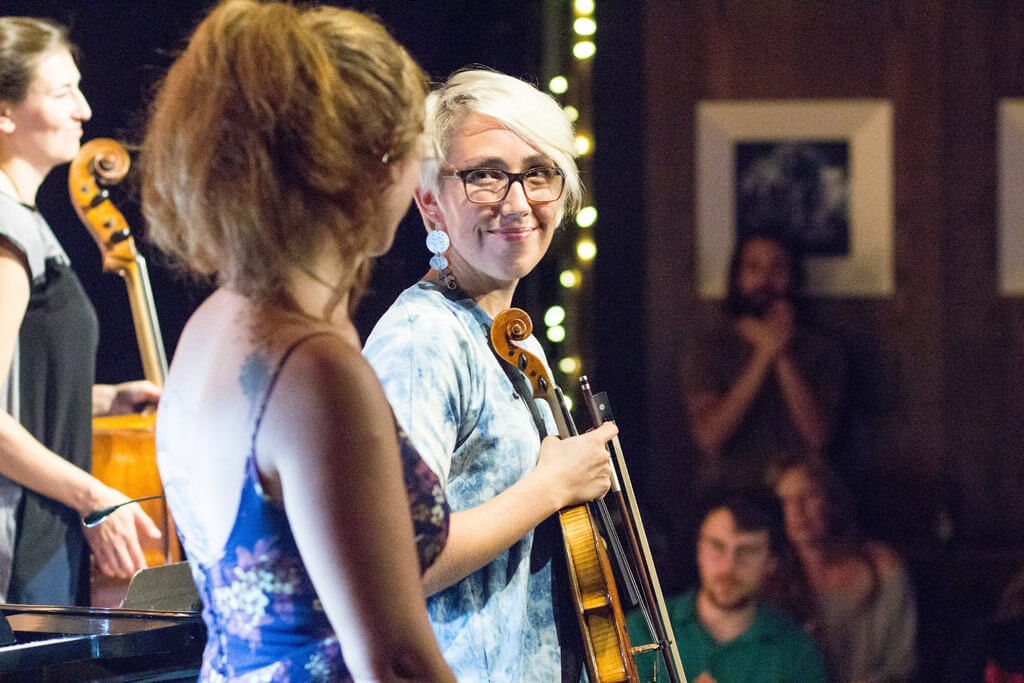
Thin Edge New Music Collective: Feldman Festival, Sept. 15 at Array Space.
There was only one piece of music on the first night of Thin Edge’s Feldman Festival. There didn’t need to be any others. At 75-minutes, Morton Feldman’s “Piano, violin, viola, cello” (his last written work before his passing) is in an exceptionally rare category of chamber music that crosses the one hour mark. But while listening to the performance, it can feel far longer. As a result, it is infrequently performed.
But perhaps I’m getting ahead of myself.
First and foremost, the performers at Thin Edge New Music Collective (Rachael Abramoff, Cheryl Duvall, Ilana Waniuk, and Dobrochna Zubek on viola, piano, violin, and cello respectively) deserve an immense amount of praise for attempting this work. It is not idiomatic and intensely unforgiving. This was not a perfect performance, but frankly, I’m not sure if a perfect live performance is possible — or even desired. Most of the music relies on fragile tones at soft dynamics that constantly feel as though they will break at any second. Even though the musical ideas presented are “simple” and not very technical, Feldman’s constantly changing meter means performers must always be alert. It is very unflattering music for the performers. I do not doubt for a second the authenticity of Duvall glibly commented about the state of her back at the end of the concert. In spite of this, Thin Edge deserve just credit for a successful performance.
Feldman’s final composition, and most of his later music, spends a great deal of time exploring the timbre of individual instruments. This quartet epitomizes his conception of these ideas. In the nearly thirty years since this was first composed, there has been plenty of other music written that is far more “radical.” Music that was and is written to push the extremes of what can or should be done on a given instrument. Feldman uses a comparatively limited array of techniques consisting mostly of straight tones, harmonics, and sustained chords. No tricks. No experimental string techniques. The pianist spends the entirety of the concert on the keyboard, which is seemingly passé when compared to the timbers explored today.
But something very strange happens over the course of this piece. Seventy-five minutes is an awfully long time to hear a limited vocabulary of musical ideas at a constant slow tempo. So limited that when a new idea is introduced it becomes much more important. Feldman was obsessed with single or flat coloured, abstract modernist painting (particularly that of Rothko). Like those paintings, small imperfections on a solid red canvas are no longer imperfection but invaluable. They are what define the art’s character, this struggle for objectivity that is always just barely out of reach. Feldman is interpreting these ideas as best he can in a musical context.
As such, when Feldman moves the piano from static chords to a slow appoggiatura (which sounds eerily like Debussy’s “Des pas sur la neige” — an astute observation in a pre-concert by composer Linda Catlin Smith) it’s not just a new idea but a radical innovation. When you hear so many repetitions of any singular idea at slow tempi, it plays tricks on your head. When Feldman introduces a pizzicato figure it is not just a pizzicato. It’s shocking. And loud. The briefly used dotted-eighth rhythm? It feels like a pulse.
With these small divergences, the natural desire is for development. Feldman never gives it to you. He moves backwards and repeats what you’ve already heard immediately after introducing new ideas. It’s maddening. This idea of repetition and return genuinely toys with your memory. At some point, you may even be unsure if what you are hearing is new or a repetition. Again, 75–minutes is a very long time.
Eventually, Feldman introduces a four-note scale. Immediately after, it ends.
After hearing at most four to five ideas repeated for such an extended duration, when the music finally ends so abruptly with no preparation you are confounded more than anything else. “Maybe this could have gone on longer” was my first instinct. Friends I was with echoed a similar sentiment. Maybe 75–minutes wasn’t enough? When hearing music so repetitious suddenly end, and on a new idea no less, your instinct is that this could be repeated forever. Maybe it could have been.
Thankfully for the Thin Edge players, yes, Feldman’s music is finite. But sometimes it can feel infinite. Thirty years after the fact there has been a lot of music that has supplanted and built on Feldman’s aesthetic foundation. This composition still carries enough weight to retain relevance to an audience and be challenging to one’s concepts of time and duration.
#LUDWIGVAN
Want more updates on Toronto-centric classical music news and review before anyone else finds out? Get our exclusive newsletter here and follow us on Facebook for all the latest.



